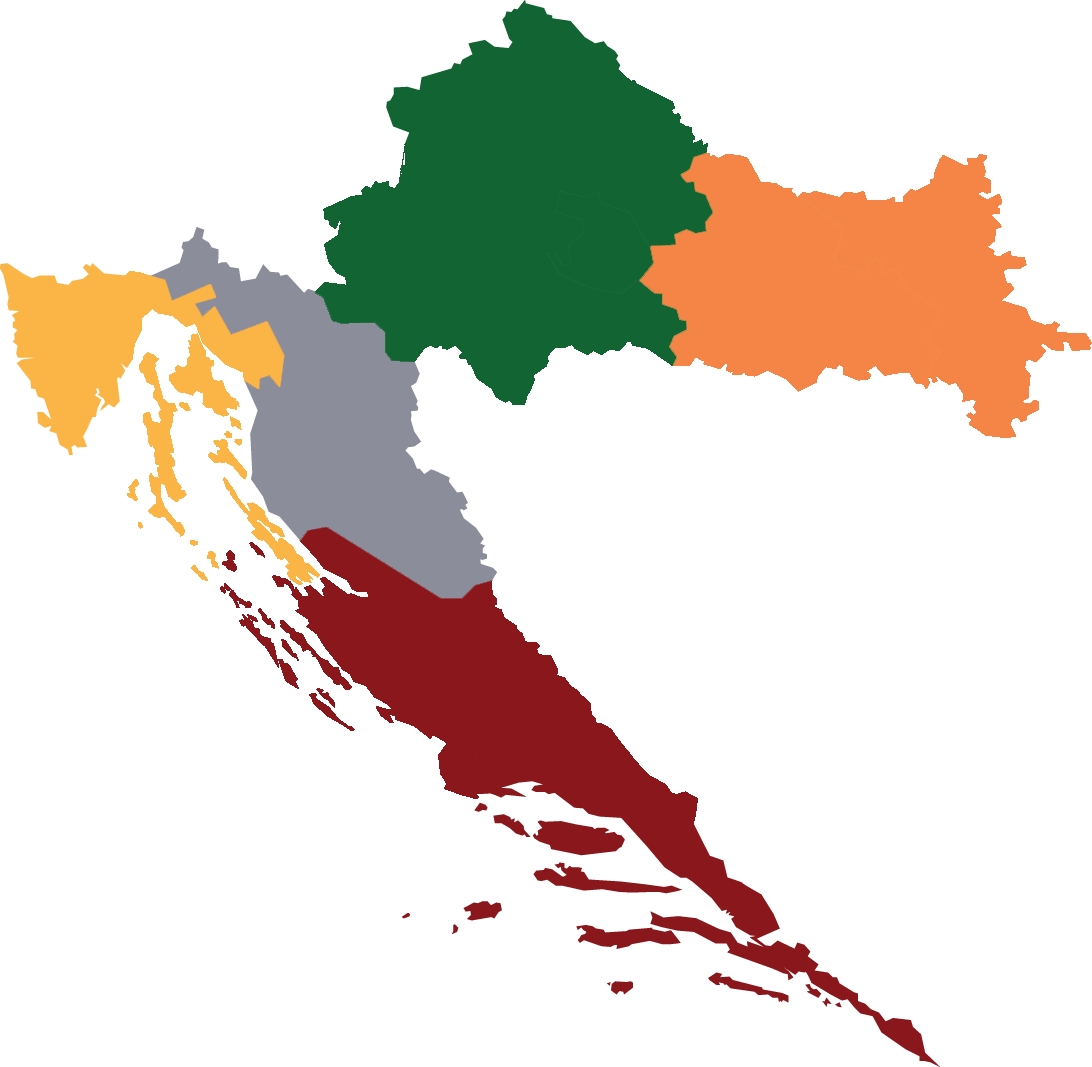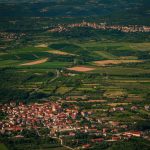 Today we take a look at the winemaking regions of Croatia, give you a broad overview of the main characteristics of the four regions, as well as varieties and types of wine made in them. Color-coding of the regions’ names is to show you the area on the map.
Today we take a look at the winemaking regions of Croatia, give you a broad overview of the main characteristics of the four regions, as well as varieties and types of wine made in them. Color-coding of the regions’ names is to show you the area on the map.
Slavonia and the Danube WINE region
Slavonia and the Danube region is the large, mostly flat and important agricultural region of Croatia. Geographically, the region is bounded by Drava River to the North (Hungarian border), Danube River to the East (Serbian border), Sava River to the South (Bosnia and Herzegovina border) and Ilova River to the West. It consists of 5 counties: Osijek-Baranja, Vukovar-Srijem, Brod-Posavina, Požega-Slavonia and Virovitica-Podravina, and is contained within Eastern Continental Croatia ZOI (Protected Designation of Origin). Grapes have been grown and wine has been made in the region since pre-Roman times, not in the low and flat areas which are mostly used for other agricultural products, but on gently sloped hills with an altitude between around a hundred and 250 meters. The climate of the region is mild continental, with the rainfall equally distributed throughout the year. Those conditions favour the varieties present in continental Europe, and the most common white varieties are graševina, rhein riesling, chardonnay and pinot grigio of the whites; frankovka, cabernet sauvignon, merlot and pinot noir of the reds. The most important and the best-known winemaking locations in the region are Kutjevo, Baranja and Srijem.Croatian Uplands WINE REGION
Croatian Upland is the winemaking region in the North-Western part of Croatia, and includes sub-regions Moslavina, Prigorje-Bilogora, Zagorje, Međimurje, Plešivica and Pokuplje, and is contained within the Western Continental Croatia ZOI (Protected Designation of Origin). The vineyards in this region are mostly located at the altitude of 100 to 400 meters, and most vineyards have been cultivated on the lower parts of the southward-facing slopes of various hills and mountains in the region. The climate of the region is mild continental, with influences of cold air from the Alps to the North, and hot air from the Mediterranean to the South. The rainfall in the region is equally distributed throughout the year, with most of the rainfall coming during the vegetation period.- The most common white variety in Croatian Highlands is graševina, followed by rhein riesling, chardonnay, kraljevina, moslavac (šipon), škrlet, sauvignon blanc. Red wine varieties are much less common, but frankovka, pinot noir, cabernet sauvignon and portugizac can be found here. Dessert, predicate and late harvest wines are traditionally made in the region, especially in Međimurje, and yellow muscat and other varieties used for such wines can also be found here. Plešivica region is well known for sparkling wines, and Moslavina is another notable location.
ISTRIA AND THE KVARNER BAR WINE REGION
Istria and the Kvarner Bay region is the winemaking region located on the North-Western portion of the Croatian Adriatic Coastline, and includes the Istrian peninsula as well as the winemaking region around Rijeka and Opatija, as well as islands Krk, Rab, Cres, Lošinj and Pag (including smaller islands and island groups). Two Croatian ZOIs (Protected Designation of Origin) fall within this region, Hrvatska Istra and Hrvatsko primorje. Although quite large and varied with multiple characteristics (soil composition, elevation of the vineyards etc.), the climate of the region is a mild sub-Mediterranean climate typical for the region, with mild and rainy autumns and winters and arid summers, although with overall insolation reduced because of many rainy and cloudy days during the spring. The Istrian climate is unique in the sense of wind patterns, as winds bring more cool air.- The most important white varieties in the region are malvazija istarska, an indigenous wine variety from Istria and žlahtina, an indigenous variety from Krk Island (now grown elsewhere as well). The most common red varieties are teran (also an indigenous variety in Istria), merlot, cabernet sauvignon and refošk. Yellow muscat from the Momjan region, also known as muškat momjanski, is a type of dessert wine made in Istria, and the region around the town of Bakar is known for over a hundred years old tradition of sparkling wine.
Dalmatia wine region
Dalmatia is a Croatian winemaking region, and it is usually considered that Dalmatia begins just to the North of Zadar, at the bottom of the Velebit channel and includes all of the land South-East of there, including the Dalmatian Inland and all of the numerous islands. It includes 4 counties (Zadar, Šibenik-Knin, Split-Dalmatia and Dubrovnik-Neretva), and is protected by 3 ZOIs: Sjeverna Dalmacija (North Dalmatia), Dalmatinska Zagora (Dalmatian Hinterland), Srednja i južna Dalmacija (Central and South Dalmatia) plus a very small but also extremely valuable Dingač ZOI on Pelješac – plavac mali variety exclusively. This region is quite large, which results in soil characteristics being very diverse, which is part of the reason that so many indigenous varieties are found throughout the region (and the isolation of some of the islands is another reason). The climate is mild-Mediterranean, with hotter summers and quite mild winters – as it is more to the south. It rains mostly during the colder part of the year, and summers are often characterized by droughts.- The most common red wine varieties are indigenous: plavac mali (in southern Dalmatia and on the islands), babić (in Šibenik and Primošten region), tribidrag (the variety with many names, also called crljenak kaštelanski, pribidrag, primitivo and zinfandel ; being slowly re-introduced throughout Dalmatia) and plavina. The most common whites are debit (around Šibenik and in the hinterland), maraština (also called rukatac, grown throughout the region), kujundžuša (indigenous in the hinterland region, around Imotski), pošip (originally from the island of Korčula but now grown throughout the region), bogdanuša (on Hvar), vugava (on Vis) and grk (in a small region of Korčula).
Do you want to try Croatian wines?
If you want to savor the exquisite flavor of Croatian wines, look no further than wineandmore.com. Offering a wide range of wines from various winemakers, you can easily find what suits your palate.
Do you need help selecting the right wine bottle? Try one of their curated wine cases, and find the perfect vintage for any occasion!










